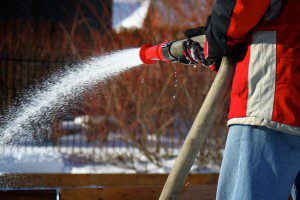
It was like that 1981 movie, “Cannonball Run,” in which a bunch of fast-car addicts get a telephone call and immediately drop what they’re doing to join a cross-country auto race. Well, even if you don’t know the movie, suffice to say a couple of Saturdays ago I got a phone call from one of my hockey pals to assemble a work party.
“My house,” Mike MacDonald texted, “about 10 a.m.”
When I first arrived at Mike’s place, just after 10, nobody was there. But within seconds several of Mike’s neighbours, Kirk Buchanan, Scott Clayworth, Jamie Steele and Jim Sproxton emerged from their homes and converged on Mike’s garage. In seconds, they’d rolled up the door and were rifling through a pile of wood in the garage. Since this was my first time, I just offered to assist.
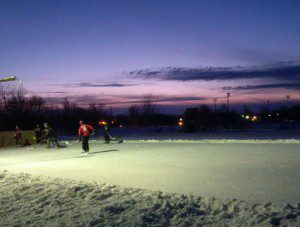
Mike was soon on the scene directing others along his fence to search for the best 2X6 boards in the snow. Then, like a bucket brigade, the volunteers trooped planks into the common open space behind that row of houses, the Bonner playground, and laid them out on the snow. Meanwhile, somebody else unwound a tape measure and drove stakes into the snow in the configuration of a skating rink, roughly 90 feet long and 45 feet wide.
“Should be a good one,” I heard Mike say, “if this crazy warm weather doesn’t melt it all.”
For four years now, Mike MacDonald and his neighbours and friends have convened in the open space of that playground to build a neighbourhood ice rink. Naturally, they sought permission from the township; in fact, in Year Two of the rink-building bee, Council approved funds to have the playground land levelled to ensure a bigger, more even ice surface.
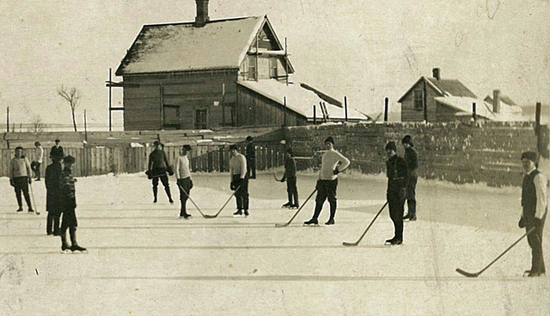
And for a couple of years, MacDonald’s oldtimers hockey team – the Uxbridge Oilies (full disclosure – I’m a member) – have contributed funds to buy the massive rink liner on which the thousands of litres of water are poured to create the rink. The rest is left to the protocol of every backyard rink since hockey was born in this country over 200 years ago. (For the record, recreational hockey was first played on frozen ponds near King’s College at Windsor, Nova Scotia, in 1803.) Everybody shares flooding duties with backyard hoses, scraping shifts with shovels or snow blowers, and access to the rink, whether for ice tag, crack-the-whip, figure skating or shinny hockey.
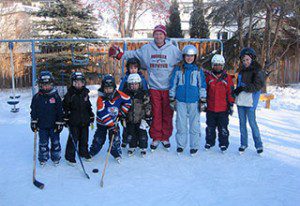
Some backyard rinks are legendary. There was the ice surface in Brantford, Ont., where five Gretzky youngsters – including Wayne – stick-handled around Javex bottles their father Walter had placed on the natural ice; the rink was euphemistically known as “Wally’s Coliseum.” Renowned artist Charles Schultz had his character Woodstock skate on a frozen birdbath in his “Peanuts” cartoons, but in real life as a boy Charlie insisted his mom don the goalie pads to take his practice shots on the family backyard rink in Minneapolis.
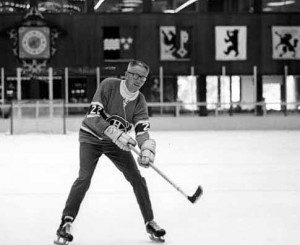
Another involved the back lot at a northern Ontario dairy, where the non-cream by-product (i.e. skimmed milk) was allowed to settle and freeze on the ground each winter to provide a milk-white ice surface for local skaters. A recent Globe and Mail poll elicited tales and pictures from dozens of backyard ice-rink creators, including one in Edmonton who marvelled at his kids’ response.
“My boys will choose to skate in minus-20 Celsius over playing video games,” Edmontonian Geoff Clarke told columnist Roy MacGregor.
My backyard concoction definitely figures among the non-legendary rinks. In 1957, when I got my first hockey equipment, I insisted on having an ice surface in our Agincourt, Ont., backyard where I could practise. Problem was my dad, who worked late-night hours covering music acts in Toronto, couldn’t help maintaining the rink when I needed him most – at night. So my mom did what she could.
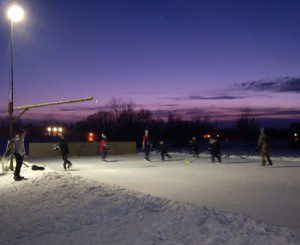
As I tamped the snow, built up the edges with snow scrapings and even installed tins for goal posts, each night my mom dutifully threaded the hose through a basement window, turned on the tap and ensured that I got all the water I needed. It was often so cold then, the hose froze and Mom had to haul it back into the basement to thaw for the next flood. There will never be enough moms’ names engraved on the Stanley and Memorial Cups for my liking.
Back at the Bonner playground rink, one day we set up the boards; the next day came the flood. And, as the water cascaded by the thousands of litres onto the huge rink liner, one of Mike MacDonald’s neighbours, Wayne Webster, began building a tripod with a long pole extending high in the air above the ice surface. As he worked, I asked what the contraption was.
“A rink light made from a parking-lot lamp,” somebody said, “with a motion sensor.”
Necessity may be the mother of invention, but only the backyard ice rink fosters such creativity and community spirit.